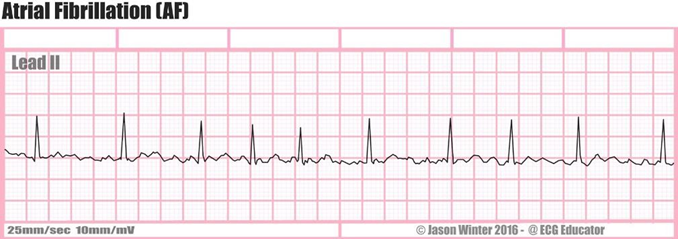A nurse is assessing a client who has atrial fibrillation. Which of the following pulse characteristics should the nurse expect?
Irregular
Bounding
Not palpable
Slow
The Correct Answer is A
A In atrial fibrillation (AF), the electrical activity in the atria is chaotic, leading to an irregularly irregular ventricular response. As a result, the pulse felt at the radial artery will be irregular, with no discernible pattern. The irregularity is a hallmark feature of AF and is often described as "irregularly irregular."
B Bounding pulses are characterized by a strong and forceful pulsation felt at the arterial pulse sites. In atrial fibrillation, the irregular and rapid ventricular response can lead to an increased stroke volume and forceful contraction of the left ventricle during diastole, resulting in bounding pulses. However, bounding pulses are not typically associated with atrial fibrillation; they are more commonly seen in conditions such as aortic regurgitation or hyperdynamic circulation.
C In some cases of atrial fibrillation, especially if the ventricular rate is very rapid or irregularly irregular, the pulse may not be palpable due to the inconsistent ventricular contractions.
However, in most cases of atrial fibrillation, a pulse is palpable, albeit irregular.
D Atrial fibrillation can result in a rapid ventricular response, leading to a fast heart rate. However, the pulse rate can vary widely among individuals with atrial fibrillation. While some may have a rapid heart rate (tachycardia), others may have a slower heart rate (bradycardia), depending on factors such as concomitant medications, autonomic tone, and the presence of underlying heart disease.
Nursing Test Bank
Naxlex Comprehensive Predictor Exams
Related Questions
Correct Answer is C
Explanation
C. Mean arterial pressure (MAP) reflects the average pressure in the arteries during one cardiac cycle and is an important indicator of tissue perfusion. A MAP of 56 mm Hg is below the normal range (typically >60 mm Hg) and may indicate inadequate tissue perfusion. While norepinephrine is commonly used to increase blood pressure and improve tissue perfusion in hypotensive patients, a MAP of 56 mm Hg suggests that the current infusion rate may not be sufficient to maintain adequate perfusion, and adjusting the infusion rate may be warranted.
A. Norepinephrine is a vasopressor medication primarily used to increase blood pressure in patients with hypotension or shock. A low pulmonary artery wedge pressure (PAWP) suggests decreased preload, which may indicate hypovolemia or inadequate fluid resuscitation. In this case, adjusting the norepinephrine infusion rate may not be necessary, but rather addressing the underlying cause of hypovolemia or inadequate preload.
B. Systemic vascular resistance (SVR) represents the resistance the heart must overcome to pump blood into the systemic circulation. An elevated SVR may suggest vasoconstriction, which could be a desired effect of norepinephrine infusion to increase blood pressure. Therefore, an elevated SVR may not necessarily indicate a need to adjust the norepinephrine infusion rate, as it may reflect the medication's intended action.
D. Norepinephrine primarily acts on alpha-adrenergic receptors to increase blood pressure by inducing vasoconstriction. While it may cause reflex bradycardia due to increased systemic vascular resistance, a heart rate of 58 beats/min may be within an acceptable range depending on the patient's clinical condition and baseline heart rate. Therefore, a slow heart rate alone may not necessarily indicate a need to adjust the norepinephrine infusion rate unless it is associated with signs of inadequate tissue perfusion or other concerning symptoms.
Correct Answer is C
Explanation
C Atrial fibrillation (AF) is characterized by rapid, irregular electrical activity in the atria, leading to an irregularly irregular ventricular response. AF often results in palpitations, fatigue, and dizziness due to the irregular heart rhythm and inefficient cardiac output. A significant pulse deficit may also be present due to the irregularity of the ventricular response compared to the atrial activity. Given the sudden onset of irregular palpitations, fatigue, dizziness, and a significant pulse deficit, atrial fibrillation is a likely dysrhythmia in this scenario.

A First-degree AV block is characterized by a prolonged PR interval on the electrocardiogram (ECG), indicating delayed conduction between the atria and ventricles. While it can indicate conduction system abnormalities, it typically does not result in rapid or irregular palpitations, fatigue, or dizziness.
Therefore, it is less likely to be the cause of the client's symptoms.
B Sinus tachycardia is characterized by a rapid heart rate originating from the sinus node, typically with a regular rhythm. While sinus tachycardia can cause palpitations and fatigue, it is less likely to result in an irregular heart rate with a significant pulse deficit. Therefore, it is less likely to be the cause of the client's symptoms.
D Sinus bradycardia is characterized by a slow heart rate originating from the sinus node. While sinus bradycardia can cause fatigue and dizziness, it typically does not result in a rapid or irregular heart rate. Therefore, it is less likely to be the cause of the client's symptoms.
Whether you are a student looking to ace your exams or a practicing nurse seeking to enhance your expertise , our nursing education contents will empower you with the confidence and competence to make a difference in the lives of patients and become a respected leader in the healthcare field.
Visit Naxlex, invest in your future and unlock endless possibilities with our unparalleled nursing education contents today
Report Wrong Answer on the Current Question
Do you disagree with the answer? If yes, what is your expected answer? Explain.
Kindly be descriptive with the issue you are facing.
